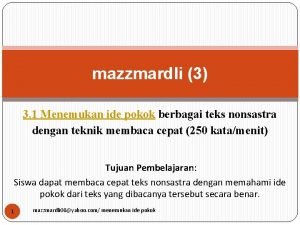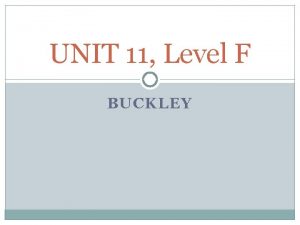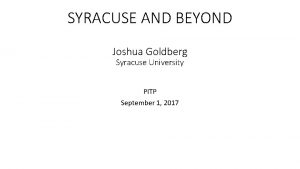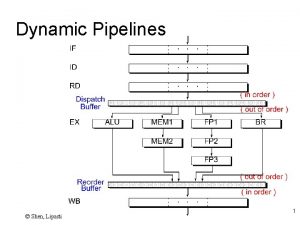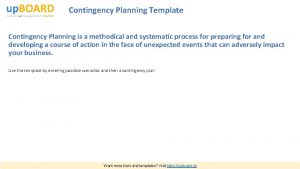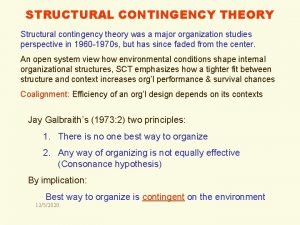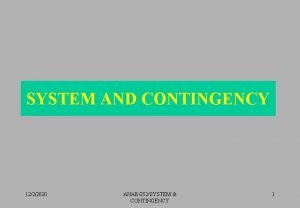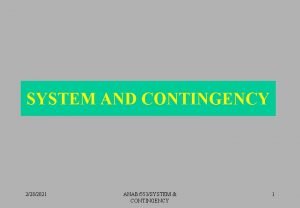Learning Contingency Analysis IDE 712 Wenjie Shen Syracuse















- Slides: 15

Learning Contingency Analysis IDE 712 Wenjie Shen Syracuse University

Content 01 02 03 04 Introduction Application Pros & Cons Assessment Activity

Introduction Overview Purpose Context

Overview Learning Contingency Analysis is a task analysis in a learning environment. Based on behavioral philosophy, it deals with identifying the behaviors to be taught and the sequence of these behaviors, in order to determine the best instructional sequence and strategies. Purpose sequencing • In what order should content be taught? • Under what instructional conditions would content be best taught? Facilitate positive transformation from prior learning to current learning 4

Sequencing rules Superordinate/Subordinate X is prerequisite for Y Teach X before Y Coordinate relationship Output of X is input for Y Teach X before Y Shared elements X and Y have a common element Z Teach Z before X or Y No relationship X and Y have no relationship Teach X or Y in any order (Gropper, 1974) 5

Procedure for Conducting Learning Contingency Analysis Context: programed instruction 1 2 4 3 Sequence Determine Identify the Specific Sequential Task Behavior Dependencies the 8 7 5 Plan the Instructional Progression 6 Analyze the Criterion Behavior Select Adjust for Alternative Individual Instructional Differences Approaches Behaviors • • • Unit size Mode Degree of prompting Content type Frequency/Variation • • Learning requirements Learning difficulties Performance requirements Performance mode 6

Application

Application of Learning Contingency Analysis Step 1 Identify the task Compute the amount of interest on a loan when given the amount of the loan, the duration and the interest rate Step 2 Identify the specific behaviors • Multiplication • Manipulation • Converting percentages to decimals Step 3 Determine the sequential dependencies • Must learn how to add before learning how to multiply • Must learn multiplication facts before learning complex multiplication • Must learn equation for computing interest before learning to compute interest • Must learn concept of loan, interest and interest rate before learning equation 8

Application of Learning Contingency Analysis Step 4 Sequence the behaviors • • Review basic addition first Review simple multiplication facts Review/teach complex multiplication Teach concept of loan Teach concept of interest and interest rate Teach substitution of values into equation Teach solving interest equation Step 5 Plan the instructional progression • • • Group addition into one lesson Group multiplication into one lesson Group concepts of loan, interest & rate into one lesson Group equation into one lesson Group solving equation into one lesson Step 6 Analyze the criterion behaviors • Determine the specific chain of behaviors 9

Application of Learning Contingency Analysis Step 7 Select alternative instructional approaches • • • Step 8 Adjust for individual differences • Pretest to assess each student’s knowledge • Place students into instructional sequence depending on his/her pretest score Show completed examples Review the concepts of a loan, interest rates Review multiplication Practice learning the equation Practice substituting values into the equation Practice solving the equation 10

Pros & Cons

Advantages Disadvantages • Very time consuming analysis • Bases instructional decisions on research evidence • Identifies an instructional sequence to facilitate transfer of learning • Does not deal with mental processing or cognition co ns • Clearly identifies specific behaviors required for tasks • May exclude the “big picture” by focusing narrowly on specific behaviors pr os • Provides an indication of how to teach different types of content • Inappropriate for tasks that are not directly observable • Requires highly skilled analyst • Requires very detailed analysis • Relies on outdated programmed instruction framework 12

Assessment activity

Referring to the i. Pad example of our class, discuss with people next to you to conduct a brief learning contingency analysis on “how to use i. Pad to download an app” for an elder teacher who has no prior experience of using i. Pad. 14

Thank You March 2 nd 2019
 Scp 712
Scp 712 Psychic suzanna schedule 2022
Psychic suzanna schedule 2022 Emily dickinson 712
Emily dickinson 712 Bagaimana anda mendefinisikan ide-ide melalui outline
Bagaimana anda mendefinisikan ide-ide melalui outline Arti ide pokok
Arti ide pokok Jack buckley syracuse
Jack buckley syracuse Closed captioning services syracuse
Closed captioning services syracuse Cubo de syracuse
Cubo de syracuse Syracuse veterans transition program
Syracuse veterans transition program East syracuse police department
East syracuse police department Roman catholic diocese of syracuse
Roman catholic diocese of syracuse Syracuse university pool
Syracuse university pool Marina artuso syracuse
Marina artuso syracuse Sheldon stone physics
Sheldon stone physics Syracuse facilitated communication
Syracuse facilitated communication Ontario lowlands
Ontario lowlands




